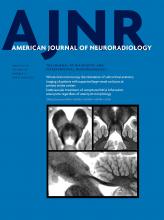Abstract
BACKGROUND AND PURPOSE: Increased CSF stroke volume through the cerebral aqueduct has been proposed as a possible indicator of positive surgical outcome in patients with idiopathic normal pressure hydrocephalus; however, consensus is lacking. In this prospective study, we aimed to compare CSF flow parameters in patients with idiopathic normal pressure hydrocephalus with those in healthy controls and change after shunt surgery and to investigate whether any parameter could predict surgical outcome.
MATERIALS AND METHODS: Twenty-one patients with idiopathic normal pressure hydrocephalus and 21 age- and sex-matched healthy controls were prospectively included and examined clinically and with MR imaging of the brain. Eighteen patients were treated with shunt implantation and were re-examined clinically and with MR imaging the day before the operation and 3 months postoperatively. All MR imaging scans included a phase-contrast sequence.
RESULTS: The median aqueductal CSF stroke volume was significantly larger in patients compared with healthy controls (103.5 μL; interquartile range, 69.8–142.8 μL) compared with 62.5 μL (interquartile range, 58.3–73.8 μL; P < .01) and was significantly reduced 3 months after shunt surgery from 94.8 μL (interquartile range, 81–241 μL) to 88 μL (interquartile range, 51.8–173.3 μL; P < .05). Net flow in the caudocranial direction (retrograde) was present in 11/21 patients and in 10/21 controls. Peak flow and net flow did not differ between patients and controls. There were no correlations between any CSF flow parameters and surgical outcomes.
CONCLUSIONS: Aqueductal CSF stroke volume was increased in patients with idiopathic normal pressure hydrocephalus and decreased after shunt surgery, whereas retrograde aqueductal net flow did not seem to be specific for patients with idiopathic normal pressure hydrocephalus. On the basis of the results, the usefulness of CSF flow parameters to predict outcome after shunt surgery seem to be limited.
ABBREVIATIONS:
- ACSV
- aqueductal CSF stroke volume
- iNPH
- idiopathic normal pressure hydrocephalus
- IQR
- interquartile range
- MMSE
- Mini-Mental State Examination
- NPH
- normal pressure hydrocephalus
- PC
- phase-contrast
- TUG
- Timed Up and Go Test
- © 2019 by American Journal of Neuroradiology












